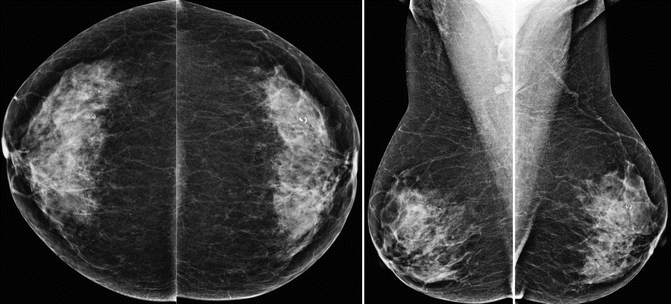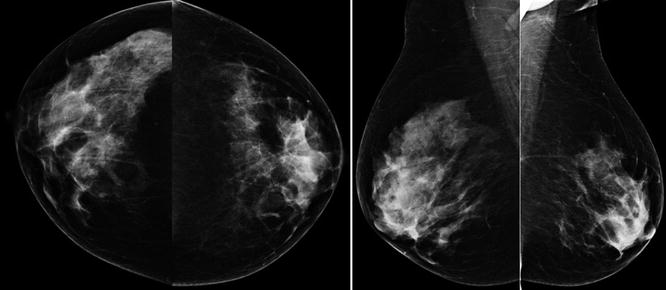(1)
Chennai Breast Centre, Chennai, India
Breasts are generally symmetric structures with similar densities and architecture (Fig. 7.1). However, asymmetric densities are a frequent finding on mammography and have been reported to occur in 3 % of mammograms. Asymmetric density represents an area of tissue with fibroglandular structures that is more extensive in one breast relative to the corresponding region in contralateral breast. Once asymmetric density is identified on a mammogram, its nature has to be determined.


Fig. 7.1
Both breasts in CC and MLO views showing symmetry with similar architecture
The 4th edition of ACR BI-RADS published in 2003 has developed a lexicon for asymmetry. There is no change in the 2013 edition. As a descriptor, the use of the word asymmetry is preferred over asymmetric density as the word density is also used to describe the attenuation characteristics of a mass.
1.
Asymmetry
2.
Global asymmetry
3.
Focal asymmetry
4.
Developing asymmetry
Asymmetry
When a potential mass is seen only in one view/projection on a mammogram, it is called an asymmetry until its three-dimensionality is confirmed. Asymmetries are planar, lack convex outward borders, and lack three-dimensional mass (Fig. 7.2). They contain interspersed fat. Superimposition or summation shadow of normal fibroglandular tissues in one projection is the commonest cause of asymmetry.


Fig. 7.2
CC and MLO views showing asymmetry in the left upper outer quadrant
Global Asymmetry
Global asymmetry on a mammogram involves a larger area of breast tissue, at least a quadrant, with asymmetry relative to the corresponding region in the contralateral breast without any associated mass, calcifications, or architectural distortion (Fig. 7.3).


Fig. 7.3




CC and MLO views: global asymmetry seen in right MLO views and CC views. Greater volume of the breast tissue is seen over a substantial portion of the right breast relative to the corresponding region in the left breast. There is no associated mass, suspicious calcifications, or architectural distortion
Stay updated, free articles. Join our Telegram channel

Full access? Get Clinical Tree







